This post provides step-by-step instructions on how to create and implement an effective SEO plan.
This help is for you if you want to move up in the Google rankings.
What Is an SEO Strategy?
- Create a list of keywords
- Analyze Google’s First Page
- Identify Your Competitors
- Make something better or different
- Include a Hook
- Optimize For On-Page SEO
- Optimize For Search Intent
- Focus on Content Design
- Build Links to Your Page
Step 1: Create a list of keywords
The first step in any good SEO strategy is generally to do keyword research.
And what’s the best way to find keywords that people who are likely to buy from you look for?
Use Google Suggest
When you type a word into Google’s search area, it will show you a list of ideas:

Because they come from Google, these are often great terms for SEO.
In other words, you know that people are looking for them.
Also, “long tail keywords“, which are longer, tend to be less competitive than “short tail” keywords.
So it’s much easier to rank for long tails, even though they don’t get as many searches.
I think you should type a few different topics into Google until you have a list of about ten.
Use a keyword tool like Semrush or Ubersuggest to determine the frequency of searches for those terms and the level of competition.
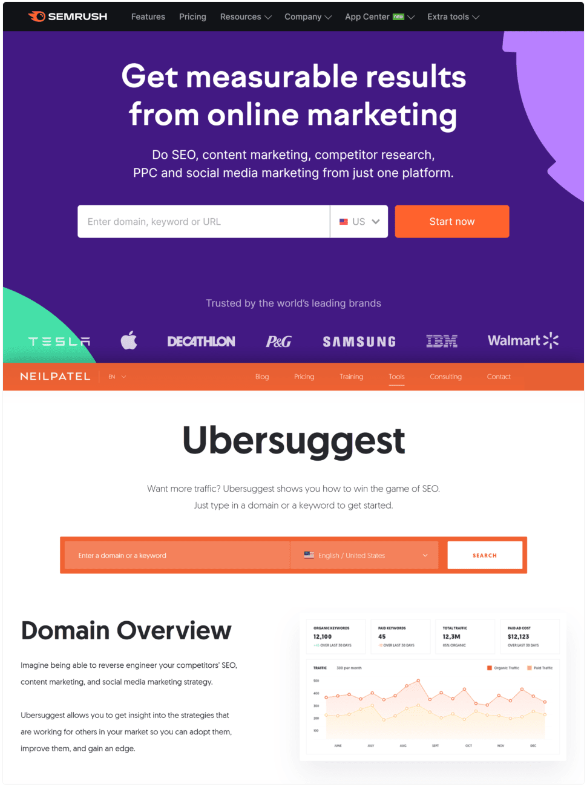
Step 2: Analyze Google’s First Page
Okay, so you found a few terms.
Let’s check out who already ranks for those keywords.
Just type one of the topics you found into Google to do that.
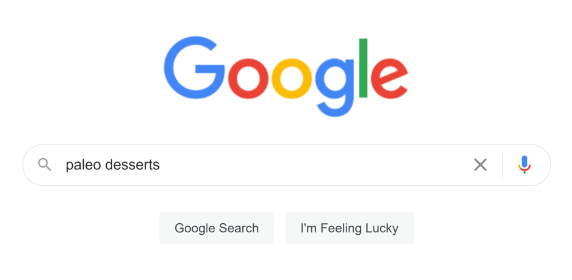
Look through the first 10 results:
Write down any patterns you see.
Such as, the SERPs for “SEO Tools” are FULL of lists of tools:

You should know that most of the first page results are list posts if you want to write about that subject on your site.
You might also want to write a list post for your blog.
Step 3: Identify Your Competitors
When I look at SEO competitors, Semrush is my favorite tool. They have a tool that makes the process very simple and quick.
Type your URL into the box that says “Domain Overview” first:
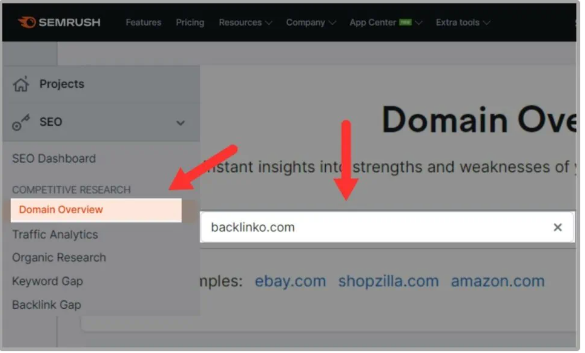
Then find the “Main Organic Competitors” part at the very bottom of the page.

These websites are your rivals; they rank for the same keywords and try to reach the same people as you.
You can see all of your rivals and more useful information if you click on the “View all…” button.
The amount of traffic these sites get and how many keywords you share with them are two things you can look at:
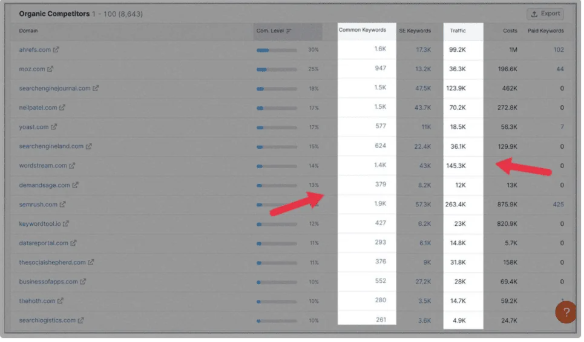
That part called “Common Keywords” is helpful because it tells you how many terms you share with each site.
When you see sites that use a lot of popular keywords, you can think of them as competitors.
You should have found at least four to five top organic competitors by the end of this step.
Step 4: Make something better or different
It’s now time to make some really great material.
You can do one of two things with SEO content:
Choice 1: You can make something different.
Choice 2: You can make something better.
There are times when you want to make something bigger and better than what’s already there.
(Also Called “The Skyscraper Technique”)
But sometimes it’s better to have something completely different.
Why?
For the reason that it makes your pages stand out.
As an example:
I set out to write a piece of writing about “Mobile SEO” some time ago.
I also saw that Google’s first page was full of list posts like “X Ways to Mobile Optimize Your Site.”
Now:
A longer post like “150 Ways to Mobile Optimize Your Site” would have been better from me.
That wouldn’t make sense, though.
I made something completely different instead.
In particular, I put out the definitive guide to mobile performance.
Step 5: Include a Hook
In 2024, you need backlinks if you want to move up in the search engine results.
(A lot of them.)
In fact, a study by Stone Temple Consulting that was posted on the Moz blog says that links are still highly linked to being on the first page of Google.
That means they’re still a big part of how Google ranks sites.
How do you do it? That’s the question.
In that case, you need to find out why people in your industry link to certain pieces of information.
(Also called “The Hook”).
Then, put that “Hook” in your writing.
Take a look at a real-life sentence:
I began to notice that more and more writers were writing about voice search a while ago.
Step 6: Optimize For On-Page SEO
The goal of this step is to make your text SEO-friendly by using keywords.
I couldn’t write a whole post about on-page SEO because it’s too big.
This video can help you learn more about how to make your writing better for SEO.
That being said, here are three important on-page SEO strategies that I think you should focus on in 2024.
Internal Linking
Yes, linking within a site still works.
You need to do it right, though.
You want to link from web pages with a lot of authority to pages that need more authority.
Semantic SEO
Finally, I make sure that my text is Semantic SEO-friendly.
To use different words:
I look for words that are like my goal keyword.
After that, I use those words in my writing.
Type your term into Google Images to do this yourself.
Google will then give you words and phrases that they think are connected to that subject:

After that, type the same word into a regular Google search. Then scroll down until you see “Searches related to…”
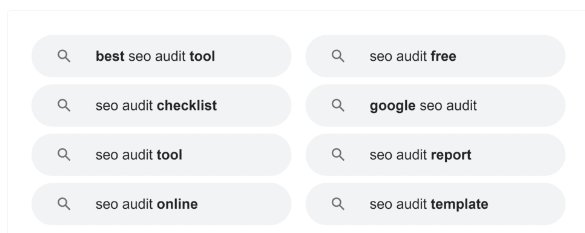
In the end, use any of the terms you found in your writing:
You are now ready.
Step 7: Optimize For Search Intent
Which means: The Skyscraper Method 2.0.
Let me give you a quick example of how this works.
I wrote a post about getting more people to visit your site a few years ago.
It worked out fine.
To my surprise, it never made it into the top 5 for my keyword (“increase website traffic”).
I found out why when I looked at Google’s first page:
That keyword’s search intent wasn’t met by my page.
Let me explain…
Most of the material that ranked for “increase website traffic” had short tips on how to get more visitors.
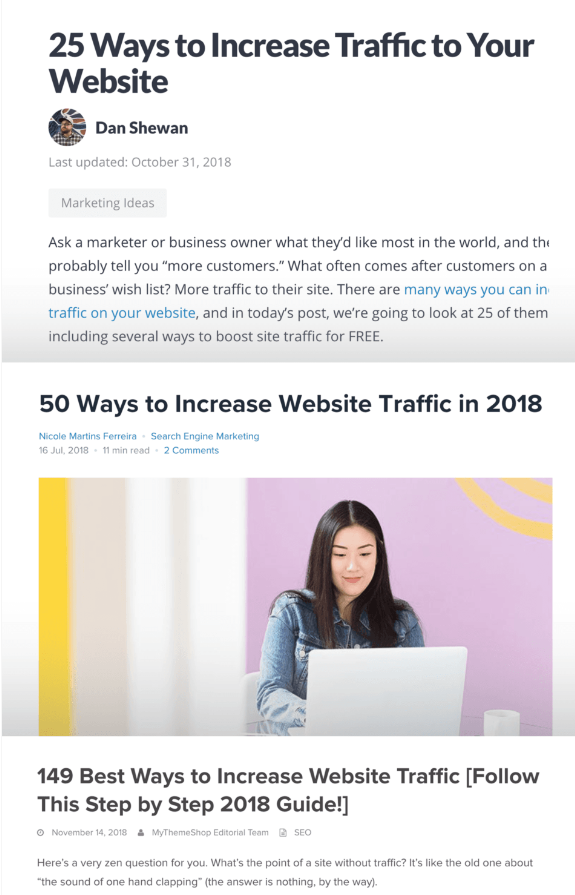
Step 8: Focus On Content Design
The design part of content marketing might not get enough attention.
You could have the best writing ever.
But if this is how it looks…
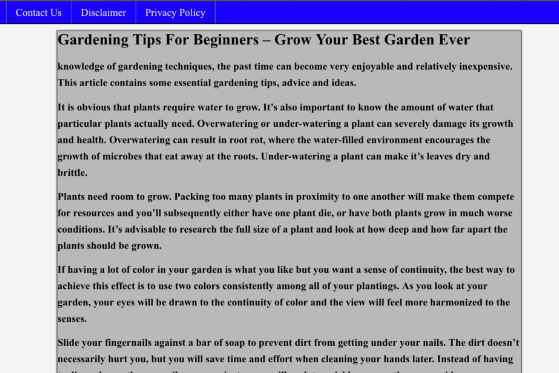
‘normally not going to get much support.
Thus, I allocate a substantial portion of my marketing funds to the creation of content.
For example, you’ve probably seen one of my most important guides:
Using WordPress, these guides were completely planned and written from scratch.
(That makes them pricey to make.)
As a result:
You don’t have to spend a lot of money on great content design.
That being said, here are 4 types of visual material that are really simple to make.
Charts and graphs
There’s at least one chart in every post because they work so well.

Why?
For the reason that they make facts simple to understand.
Take this number from my guide to mobile SEO as an example.
I do not know about you, but 27.8 billion things are hard for me to picture.
So I asked our artist to make a nice chart.

On top of that, your chart may be used in a blog post… and give you a link back:

Step 9: Build Links to Your Page
Now is the time to get people to link to your material.
We’re going to focus on three link-building methods that are really effective at the moment.
Building a Broken Link
This is where you can find a broken link on someone else’s site…
…and give them your information instead.
Analysis of Competitors
This plan is from a long time ago.
It works still, though.
First, look for a site that already ranks well for the keyword you want to rank for.
Take the term “SEO Audit” as an example.
It’s on the first page, so I select it…

I should be able to get a few of the same links they have.
To do that, I look at their connections one by one.
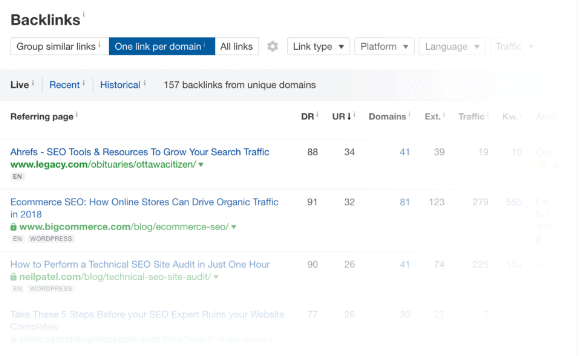
And look for places that would benefit from my link.
This time, the link to my competitor’s page is in a long list of useful links.

A list that is even better and more full if it had a link to my post about SEO audit.
The Evangelist Way
This plan isn’t so much about links as it is about getting the right people to see your material.
To be exact, people who run blogs in your field.
I’ll use an example to show how this plan works…
I wanted to get the word out about a new Skyscraper Technique case study a while ago.
Now I’d Like To Hear From You
That’s it:
My 9-step plan for 2024 SEO.
Now I want to hear from you…
Which of the ideas in today’s post are you most excited to try?
Are you going to update old information and put it back online?
You could also try making broken links.
Leave a comment below right now to let me know either way.
Content and Image Source: backlinko.com












COMMENTS (6)
There are many variations of passages of Lore m Ipsum
There are many variations of passages of Lore m Ipsum
There are many variations of passages of Lore m Ipsum
There are many variations of passages of Lore m Ipsum
[…] Blog Single […]
[…] Blog Single […]